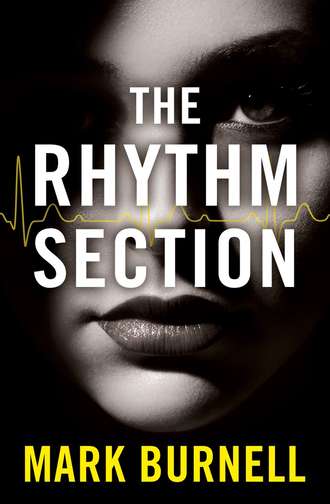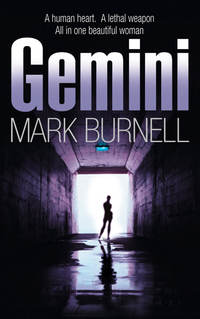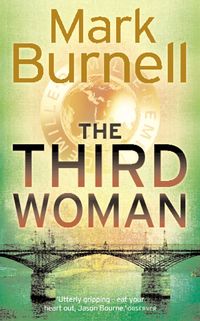
Полная версия
The Rhythm Section

THE RHYTHM SECTION
Mark Burnell

COPYRIGHT
HarperCollinsPublishers 1 London Bridge Street London SE1 9GF
www.harpercollins.co.uk
Published by HarperCollinsPublishers 1999 Copyright © Mark Burnell 1999
A catalogue record for this book is available from the British Library
All rights reserved under International and Pan-American Copyright Conventions. By payment of the required fees, you have been granted the nonexclusive, nontransferable right to access and read the text of this ebook on screen. No part of this text may be reproduced, transmitted, downloaded, decompiled, reverse engineered, or stored in or introduced into any information storage and retrieval system, in any form or by any means, whether electronic or mechanical, now known or hereinafter invented, without the express written permission of HarperCollins e-books.
Source ISBN: 9780006513377
Ebook Edition © SEPTEMBER 2012 ISBN 9780007397556
Version: 2018-07-04
HarperCollinsPublishers has made every reasonable effort to ensure that any picture content and written content in this ebook has been included or removed in accordance with the contractual and technological constraints in operation at the time of publication.
DEDICATION
To my parents, with love and thanks for your ceaseless support.
EPIGRAPH
Character is destiny.
George Eliot/Mill On The Floss
Let’s make us medicine of our great revenge,
to cure this deadly grief.
William Shakespeare/Macbeth
CONTENTS
Cover
Title Page
Copyright
Dedication
Epigraph
Foreword
0617 GMT/0117 EST
1: Lisa’s World
1
2
3
4
5
2: Stephanie’s World
6
7
8
9
10
11
12
13
3: Petra’s World
14
15
16
17
18
19
20
21
4: Marina’s World
22
23
24
25
26
27
28
5: The Rhythm Section
29
30
0617 GMT
Keep Reading
Acknowledgements
About the Author
Also by Mark Burnell
About the Publisher
FOREWORD
The Rhythm Section was first published in 1999 and the question I am most frequently asked about it is a variation of this: how did you know about 9/11 two years before it happened? The answer, of course, is that I didn’t. The reason I get asked this, however, is because of the similarities between the events of 11 September 2001 and the terrorist plot within the novel. Those similarities are not a coincidence. The terrorist plot in The Rhythm Section is actually closer in structure to the failed 1995 Bojinka plot than to anything that occurred on 9/11, but there is a strong connection between the two because 9/11 was born out of Bojinka.
On 26 February 1993, a Pakistani man known as Ramzi Yousef (probably born Abdul Basit Mahmoud Abdul Karim, according to the 9/11 Commission, although this is disputed), parked a hired Ryder van in the car park beneath the North Tower of the World Trade Center in New York. The bomb in the back of the van was intended to collapse the North Tower into the South Tower. The device detonated, killing six people and injuring more than a thousand others, but failed to topple the North Tower. In the aftermath, Yousef evaded capture and fled the United States.
The following year, on December 11, travelling on an Italian passport, Yousef boarded Philippine Airlines PAL 434, bound for Tokyo from Manila, stopping at Cebu. During the first leg of the flight, he assembled and concealed a timer-controlled bomb with components he brought on board in Manila. He then disembarked at Cebu. The device detonated over Japan, as the aircraft cruised at 33,000 feet, blowing a hole in the floor but, crucially, failing to pierce the fuselage. Astonishingly, there was only one fatality, a Japanese businessman named Haruki Ikegami, whose body absorbed much of the force of the blast. The captain diverted to the airport at Okinawa and executed an emergency landing without further loss of life.
This attack was a successful test run for a far larger operation that would employ substantially more powerful bombs. Satisfied with his progress to that point, Yousef returned to Manila and began preparations for what became known as the Bojinka plot. His chief co-conspirator in this endeavour was Khalid Sheikh Mohammed, one of the architects of 9/11, while finance was provided by Osama bin Laden.
The Bojinka plot had three distinct phases: firstly, to assassinate Pope John Paul II; secondly, to place bombs on eleven airliners flying between South-East Asia and the United States (each flight included a stop): thirdly, to fly an aircraft into the CIA headquarters at Langley, Virginia. The third phase was a reduction of a more ambitious attack that had originally included other targets, among which were the White House, the Pentagon and the World Trade Center in New York.
The Bojinka plot was scheduled for January 1995, with the first phase, the assassination of Pope John Paul II, earmarked for January 15, three days after the Pontiff’s arrival in the Philippines. However, on the evening of January 6, a fire broke out in Room 603 of the Doña Josef apartment building in Manila. Yousef had rented Room 603 and was using it as an operational base. When the Manila police raided the apartment, the plot was exposed in its entirety; the bomb-making ingredients, the plans for the assassination of the Pope, the false passports to be used on the targeted flights and a laptop detailing almost every aspect of the plan.
The Bojinka plot was over and the conspirators scattered. Khalid Sheikh Mohammed, however, remained convinced of the viability of the plan. Six years later, he revisited and refined it. 9/11 was a streamlined, simplified version of the Bojinka plot where bombs were ditched in favour of making the aircraft themselves the weapons. Like so many others, I watched the attacks on the Twin Towers as they occurred, understanding instantly that I was seeing history in the making. I remember feeling distinctly uncomfortable about the link between the plot of The Rhythm Section and the Bojinka plot, even though I could not have known at the time that what I was watching was a refined version of it.
Ramzi Yousef was eventually captured in Pakistan in February 1995 and is currently serving a life sentence of 240 years with no parole at the ADX Florence supermax prison in Colorado. Khalid Sheikh Mohammed was arrested in Pakistan in March 2003 and is being held at Guantanamo Bay pending trial.
All of this information is now universally available and has been for years. Much of it, though not all of it, was already in the public domain back in 1997 and 1998 when I was preparing and writing The Rhythm Section.
In the immediate aftermath of 9/11, I found my opinion being sought. I remember sitting on a panel of a late-night radio talk show, surrounded by experts from the intelligence community and feeling somewhat of a fraud. There was an assumption among people I met that I had some special insight to offer, that I must have had sources or contacts within the intelligence community who had provided me with raw material for the novel. This was not the case. I never met anybody from the intelligence community until after 9/11. In some instances, my insistence upon this only appeared to strengthen their suspicion: well of course you would deny it, wouldn’t you?
Interestingly, those from the intelligence community whom I have subsequently met are often more interested in the fact that I reference Osama bin Laden in The Rhythm Section. I have always found this surprising for two reasons: firstly, bin Laden is only referenced once in the novel, and rather briefly at that; secondly, although he had yet to become a household name, bin Laden was already an established and recognised terrorist entity by 1997.
The Rhythm Section was researched and written in my own pre-internet era. As a technological late adopter, I didn’t use the internet at all during the preparation of the novel. Planning was done the old-fashioned way, collating material from books and articles. It’s a method that has served me well and which I still prefer. Although I use the internet now, I still require alternative verification for research. To mis-paraphrase a quote: ‘Google will provide you with a thousand answers. A library will provide you with the correct answer.’
I always travel to the locations in which my novels are set. Again, the internet is a useful starting point and can certainly reduce the amount of time spent scouting locations. But it cannot be a perfect substitute. Authors who are over-reliant upon on the internet run the risk of getting found out and that is a serious flaw for a thriller, where the suspension of disbelief is critical. The better the research, the more likely you will be able to take the reader with you. To remind me of this, I keep a terrible novel on a shelf in my office as a permanent warning of all the pitfalls that a thriller writer needs to strive to avoid: lack of character development, an over-reliance on plot, an overly contrived plot, any form of cliché, bad dialogue, to name but a few. This novel was a huge international bestseller and comfortably one of the worst books I have ever read. Its presence in my office, and the fact that is so awful yet sold so well, serves two purposes – firstly, as a constant reminder to be vigilant, and, secondly, to remind myself that the true taste of the public is ultimately unknowable and that the Gods that govern writing are capricious.
The Rhythm Section is written almost exclusively from the perspective of its central character, Stephanie Patrick. This was a proactive choice that was made much easier by the decision not to dwell too much on the characters of the terrorists. In almost everything I have ever read, heard or seen, it is striking how screamingly tedious most terrorists appear to be. They are voids, character replaced by incoherent rage or dogma, often spoon-fed rather than self-generated. Nothing in them is original. I see a similarity between the type of individual who becomes a suicide-bomber and the lengthening list of men who rampage through American schools armed with assault rifles. What unites them is their extraordinary solipsism. They dehumanise their victims because they lack empathy, a key marker for psychopathy. With a suicide-bomber or a school-shooter, it’s never really about the cause or the grievance. It’s about them. Hey, look at me. Please, just for a second…
Their empty lives are given relevance for a fleeting moment, although the increasing frequency of such events inevitably dilutes and diminishes even that. I wonder whether there may be a societal connection between the increase in American school slaughters and the rise of the age of the selfie. Suicide-bombers, after all, have often resorted to narcissistic pre-recorded messages which, while chilling to watch, are also pathetic and empty, generally leaving a lasting impression that they are the calling cards of the perennial loser.
Originally, the central character in The Rhythm Section was going to be male. This decision was more of a lazy default than a considered choice. Yet, looking back, I am convinced there must have always been some part of me that knew the character should be a woman. I have no recollection now of whether I ever ascribed a name to this male character. I don’t remember anything about his background. Perhaps that is the point: he was going to be central to the story whereas Stephanie is the story. Tellingly, when the central character was going to be male, I was focused on the plot. Once Stephanie assumed that role, I was focused on her and the plot evolved around her.
A lot of writing is procedure – planning, execution, revision – but occasionally one has a ‘eureka’ moment. And so it was with Stephanie. Once I committed myself to a female central character, Stephanie arrived fully formed, almost instantaneously. This I remember clearly. She came with a look, an attitude and a well-defined background. Most significantly, she had a name. I never considered other options. She was always Stephanie Patrick and that name represented to me everything that she was. Even the sound of it seemed to embody somehow the crystallisation of all that she was before The Rhythm Section begins, and of everything she then becomes.
If Stephanie’s greatest asset is her intelligence, her greatest flaw may be her temperament. She is difficult, spiky. She is prone to a quip when silence would be better. She’s got a smart mouth on her that can get her out of trouble, but no more frequently than it lands her in trouble. Academically gifted, she was rebellious at school just because…
Having played the part of the teenage rebel within the secure and nurturing environment of her family, her life is then ripped apart and, for all her superficial toughness, she is utterly incapable of dealing with it. By the time the novel starts, she is physically and emotionally ruined and, to a large degree, it’s self-inflicted.
This is a constant theme in Stephanie’s evolution; she may be appalled by her own behaviour and choices but she is no fan of self-pity. She is searingly honest about her weaknesses and the poor decisions she makes. She would love to be loved but can’t see how that could happen. Or that she deserves it. When she falls for someone she can never really do it completely: total trust is just too great a leap for her. Stephanie is a woman within whom there is a perpetual state of emotional civil war.
I am pleased to have been given the opportunity to write this introduction to The Rhythm Section since Stephanie will very soon cease to exist as a purely literary character. At the time of writing, filming is underway for a screen version of The Rhythm Section. The novel has been under option constantly since it was first published in 1999 and the wait has, at times, been very frustrating. For many years, I was convinced the film would never be made. But the team that has now been assembled to change that is so gifted that I can say, in all honesty, it’s been worth the wait. Blake Lively stars as Stephanie and her performance is just mesmerising. It has exceeded everything I had hoped for and anything I had to a right to expect.
A film is a collective effort and I would like to thank the many talented people who have worked on The Rhythm Section. Few, if any, authors have been better served by cast and crew. The public face of this film is most definitely female; producer Barbara Broccoli, director Reed Morano and Blake herself are a deeply impressive trio and it feels totally appropriate that they should bring Stephanie to the screen. She would definitely approve!
Mark Burnell, September 2018
0617 GMT/0117 EST
Outside, the temperature has reached –52°C. Inside, it’s a constant 23°C. Outside, there is speed. Inside, there is stillness. Outside, the air pressure is consistent with an altitude of thirty-seven thousand feet. Inside, the air pressure is equivalent to an altitude of six thousand five hundred feet. Made from aluminium and assembled near Seattle, the dividing line between these two mutually hostile environments is just two millimetres thick.
Martin Douglas had his eyes closed but he was not asleep. The occupant of seat 49C, a resident of Manhattan and a native of Uniondale, New York, Douglas focused on his breathing and tried to ignore the tension that was his invisible co-passenger on every flight he took. The airline’s classical music channel piped Mahler through his headphones. The music took the edge off the drone of the engines, masking the tiny changes in pitch, every one of which usually accelerated Douglas’ pulse. Now, however, with soothing music in his ears and with the fatigue that follows relentless anxiety starting to set in, he was almost relaxed. His eyelids were heavy when he half-opened them. An inflight movie was flickering on the TV screens above the aisles but most of the passengers around him were asleep. He envied them. On the far side of the cabin he noticed a couple of cones of brightness falling from reading lights embedded in the ceiling. He closed his eyes again.
When the explosion occurred, North Eastern Airlines flight NE027 was flying over the Atlantic, bound for London’s Heathrow Airport from New York’s JFK. Including flight crew and cabin crew, there were three hundred and eighty-eight people on board the twenty-six-year-old Boeing 747.
First Officer Elliot Sweitzer was drinking coffee. Larry Cooke, the engineer, was returning to his seat after a brief walk to stretch his legs. The lights on the flight deck were dimmed. Outside, it was a beautiful clear night. A brilliant moon cast silver light on to the gentle ocean below. The stars glittered above the aircraft. To the east and to the north, the sky was plum purple with a hint of bloody red along the curved horizon.
The countless hours spent in a 747 simulator combined with years of actual flying experience counted for nothing in preparing the pilots for the physical shock of the blast. Sweitzer’s coffee cup flew free of his grasp and shattered on the instruments in front of him. Cooke’s seat-belt was not properly fastened and he was hurled into the back of Sweitzer’s seat. He heard his collar-bone snap.
Instantly, the flight deck was filled with mist as the howl of decompression began. Captain Lewis Marriot reacted first. Attaching an oxygen mask to his face, he began to absorb the terrifying information that surrounded him. ‘Rapid depressurization drill!’ He turned to his co-pilot. ‘Elliot, are you all right?’
Sweitzer was fumbling with his mask. ‘Okay … I’m okay …’
‘You fly it,’ Marriot commanded him, before turning to check on Cooke. ‘Larry?’
There was blood on Cooke’s forehead. His left arm was entirely numb. He could feel the break in the collar-bone against his shirt. Gingerly, he hauled himself back into his seat and attached his own oxygen mask. ‘I’ll be … fine …’
‘Then talk to me.’
On the panel in front of Cooke the loss of cabin pressure was indicated by a red flashing light. A siren began to wail. Cooke pressed the light to silence it. ‘I got a master warning for loss of cabin pressure.’
Sweitzer said, ‘We need to get to a lower altitude.’
Marriot nodded. ‘Set flight level change. Close thrust. Activate speed brake.’
A yellow light began to flash in front of Cooke. ‘I’ve got a hydraulics master caution.’ He pressed the light to reset it. Two seconds later, it went off again. ‘We’ve lost one set of hydraulics.’ The 747–200 was fitted with three different hydraulics systems. ‘I also got a fuel imbalance warning.’ A red master warning light came on, accompanied by the ringing of a bell. ‘Fire!’
Sweitzer said, ‘The auto-pilot’s in trouble. I’m getting a vibration.’
Marriot looked at Cooke. ‘Engine fire check list. What’s it on?’
‘Two.’
Under Cooke’s supervision, Marriot closed the number two engine, shut off the fuel control switch, and then pulled the number two fire handle to close the hydraulics and fuel valves. Then he twisted the handle to activate the fire extinguishers.
‘We’re losing the auto-pilot. The second set of hydraulics is going.’
‘Deactivate the auto-pilot, Elliot.’
Sweitzer nodded. ‘We’re going to have to slow her down. There’s too much vibration.’
‘Just keep her steady and make the turn. We’re heading for Gander.’
Gander, in Newfoundland, was the closest runway to them.
Sweitzer was struggling with the control column. ‘God, she’s sluggish!’
The fire bell sounded again in conjunction with a master warning light. Cooke said, ‘We need the second shot with the fire extinguisher. It’s still burning.’
‘I think we’ve got a rudder problem and maybe a jammed stabilizer. The trim’s shot to hell.’
Marriot turned the radio to VHF 1215, the emergency frequency. ‘Mayday, Mayday, Mayday! This is North Eastern Zero Two Seven. We are in emergency descent. We have structural damage. We have an engine fire, not extinguished.’
The violent deceleration hurled everyone forwards. Those whose seat-belts were unfastened were ejected from their seats. Martin Douglas was lifted from his but the belt cut across the top of his thighs and restrained him. His head hit the seat in front. The blow knocked him senseless and his body was immediately snapped back against his own seat.
He was only unconscious for three seconds. Despite being dazed, Douglas knew that his nose was broken. The back of the seat in front had crushed it and ripped the skin in several directions. Blood was seeping from the star-shaped gash but it was not slithering down his face. It was not staining his shirt or splattering his lap. Instead, it was being sucked off his skin. A sticky stream of crimson drops was hurtling forwards, flying over the seats in front, borne on the rushing air.
Further forward, part of the cabin floor had collapsed. Broken seats were wrenched from their moorings and sucked into the night. A tornado tore through the fuselage, ripping clothes from bodies, bodies from seats, hand-luggage from floors and overhead lockers. All of this debris was inhaled by some enormous invisible force towards the front of the 747. The majority of those who could were screaming, but their pitiful shrieks were lost in the roar of decompression. Others were unconscious. Or already dead.
The pain in his ears was agonizing, a consequence of the colossal percussive clap and the violent change in air pressure. But compared to the fear, his pain was a minor irritation. The terror constricted his throat, his stomach, his chest. As the aircraft began to descend, Douglas instinctively pushed against the arm-rests, raising himself upwards, stretching himself, as if to counteract, in whatever minuscule way possible, the 747’s descent. The entire aircraft was vibrating uncontrollably. To Douglas, it seemed that this was Hell and that whatever was to follow could be no worse.
The boy who had been asleep in seat 49B was no longer there. His belt had been fastened but not securely enough. The girl by the window was either unconscious or dead. Her hair was drawn forwards, masking her face, but there was a thick smudge of her blood on the window’s blind. It looked black.
Oxygen masks fell from the ceiling and were drawn towards the source of depressurization. Douglas reached for one, retrieved it by the plastic tube and yanked it towards him, placing it over his nose and mouth. Breathing through the mask proved to be harder than fixing it to his face; his lungs seemed to be shutting down, each breath becoming shallower than the one before, the time between them shrinking. Small white stars were exploding in his eyes.
He allowed himself to look around. It was dark in the cabin but of those he could see, he was one of the few who was still conscious. Even as a nervous flyer, he had never imagined that any fear could be so acute, that his worst nightmare made real would be quite so surgical in the way that it sliced him apart.







